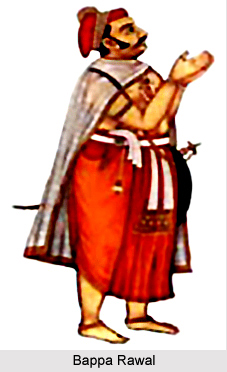 History of Rajputs reveal that the first Rajput kingdoms date back to the seventh century and it was during the ninth and eleventh centuries that they rose to fame. The four Agnivanshi clans, namely the Pariharas (of the Pratihara), Solankis (of the Chalukya dynasty), Paramara, and Chahamanas of the Chauhans rose to prominence by establishing territories and creating kingdoms.
History of Rajputs reveal that the first Rajput kingdoms date back to the seventh century and it was during the ninth and eleventh centuries that they rose to fame. The four Agnivanshi clans, namely the Pariharas (of the Pratihara), Solankis (of the Chalukya dynasty), Paramara, and Chahamanas of the Chauhans rose to prominence by establishing territories and creating kingdoms.
Chattis Rajput Kuls
The Chattis Rajkul is a list of kings of the thirty six different Indian states. Chattis Rajkul clans include clans from Suryavansha, Chandravansha, Agnivansha and Nagvansha. Suryavanshi`s are descendants of Surya, the sun god, Chandravansha being that of moon and Agnivansha meaning those born from the sacrificial fire pit. This is again divided into Guhilots, Yadu vansh, Tomar vansh, Rathore, Parmar, Chauhan, Gurjar, Solanki many more to be mentioned.
Beginning of Rajput Kingdoms
The first Rajput Empire in medieval history is Harsha`s empire who ruled over the whole of north India for forty seven years. After his death his empire broke into numerous Rajput Kingdoms. Bappa Rawal of the Gahlot dynasty established his rule in the eighth century in Chittor.
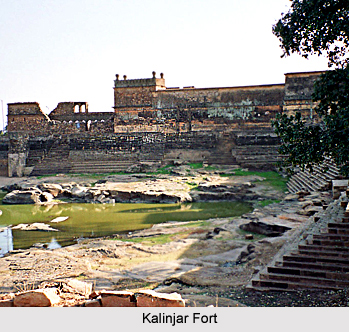 The Kachwahas dynasty from Bihar founded Gwalior and Narwar in One of their descendants, Dulah Rai established his rule in Dhundhar in the 11th century. The royal Pratiharas established their rule over Malwa the eighth and ninth centuries. One branch of the clan established a state in Mandore in the Marwar region in sixth and seventh centuries. Around ninth century the Pratiharas of Ujjain conquered Kannauj, and from this city they ruled much of northern India for a century. They went into decline after invasions of Rashtrakutas in early tenth century. The Chandela clan ruled Bundelkhand and occupied the fortress of Kalinjar; and later built the temples at Khajuraho. Intermarriage among the Rajput clans interlinked the various regions of India and Pakistan, facilitating trade and scholarship. The early eleventh century saw the reign of the Pratihara king Bhoja of Malwa. During this time art, literature and archaeology flourished.
The Kachwahas dynasty from Bihar founded Gwalior and Narwar in One of their descendants, Dulah Rai established his rule in Dhundhar in the 11th century. The royal Pratiharas established their rule over Malwa the eighth and ninth centuries. One branch of the clan established a state in Mandore in the Marwar region in sixth and seventh centuries. Around ninth century the Pratiharas of Ujjain conquered Kannauj, and from this city they ruled much of northern India for a century. They went into decline after invasions of Rashtrakutas in early tenth century. The Chandela clan ruled Bundelkhand and occupied the fortress of Kalinjar; and later built the temples at Khajuraho. Intermarriage among the Rajput clans interlinked the various regions of India and Pakistan, facilitating trade and scholarship. The early eleventh century saw the reign of the Pratihara king Bhoja of Malwa. During this time art, literature and archaeology flourished.
Rajputs under Muslim Rule
For geographical reasons, Rajput-ruled states suffered the burden of attack from the Mongol, Turk, and Afghans who constantly invaded India. In the 11th century, Mahmud of Ghazni conquered the Hindu Shahi kingdom in the Punjab which weakened the Pratihara kingdom. In the mean time the Gahadvala dynasty established a state centred around Kannauj, ruling for about a hundred years. They were defeated by Muhammad of Ghor, who sacked the city in twelfth century.
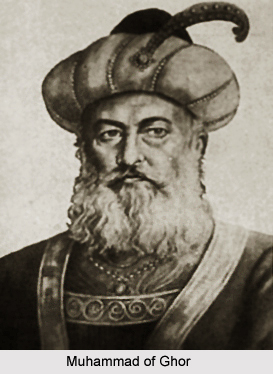 Meanwhile, a nearby state was ruled successively by the Tomara and Chauhan clans. Prithiviraj III, ruler of Delhi, defeated Muhammad of Ghor at the First Battle of Tarain. Muhammad defeated Prithviraj at the Second Battle of Tarain (1192 CE). In this battle, rampant inner conflict among Rajput kingdoms made the invaders to easily attack.
Meanwhile, a nearby state was ruled successively by the Tomara and Chauhan clans. Prithiviraj III, ruler of Delhi, defeated Muhammad of Ghor at the First Battle of Tarain. Muhammad defeated Prithviraj at the Second Battle of Tarain (1192 CE). In this battle, rampant inner conflict among Rajput kingdoms made the invaders to easily attack.
The Delhi Sultanate was established by Qutb-ud-din Aibak, Muhammad of Ghor`s successor, in the early thirteenth century. Sultan Ala-ud-din Khilji conquered in subsequent centuries Gujarat, Malwa, Ranthambhore, Chittorgarh, Jalore, and Bhinmal. All were conquered after long sieges and fierce resistance from their Rajput defenders.
Ala ud din Khilji delegated the administration of the newly conquered areas to his principal Rajput collaborator, Maldeo Songara, ruler of Jalore. Maldeo Songara was soon displaced by his son-in-law Hammir, who re-established the state of Mewar which emerged as a leading Rajput state, after Rana Kumbha enlarged his kingdom at the cost of the sultanates of Malwa and Gujarat.
The Delhi sultanate was extinguished when Babur defeated Ibrahim Lodi at the First Battle of Panipat. Rana Sanga, ruler of Mewar, fought with Babur but was defeated. Rana Sanga died soon; Mewar came under the rule of his widow, Rani Karmavati. This was menaced by Bahadur Shah, ruler of Gujarat.
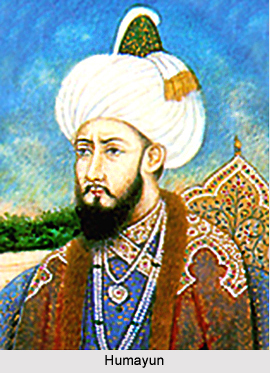 Babur`s son Humayun was a ruler who was forced to spend long periods in exile. His son Akbar, however, consolidated his inheritance and expanded what had been the Delhi sultanate into a wide empire. Part of the reason for his success was his inclusion of native Rajput chiefs into the ruling class of his empire. The Rajput chiefs cemented the alliance with marriages, with numerous Rajput noblewomen being wed to Mughal grandees. The Kachwahas were the first to extend matrimonial alliances with Akbar; they pioneered a trend that soon turned pervasive and played no small role in extending Rajput influence across the Indian sub-continent. Indeed, two successive Mughal emperors, Jahangir and Shah Jahan, were born to Rajput mothers.
Babur`s son Humayun was a ruler who was forced to spend long periods in exile. His son Akbar, however, consolidated his inheritance and expanded what had been the Delhi sultanate into a wide empire. Part of the reason for his success was his inclusion of native Rajput chiefs into the ruling class of his empire. The Rajput chiefs cemented the alliance with marriages, with numerous Rajput noblewomen being wed to Mughal grandees. The Kachwahas were the first to extend matrimonial alliances with Akbar; they pioneered a trend that soon turned pervasive and played no small role in extending Rajput influence across the Indian sub-continent. Indeed, two successive Mughal emperors, Jahangir and Shah Jahan, were born to Rajput mothers.
Rajput chiefs served as Mughal officers and administrators across the Mughal Empire. In this period, the aristocratic image of the Rajputs can be said to have shaped up. However, it was not until the reign of Akbar fifteen years later that the structure of relations between the Mughal Empire and the Rajput states began to take definitive shape. Later, Babur`s grandson Akbar attacked Chittor. After a struggle, Mewar`s chief citadel of Chittor finally fell to Akbar.
After Rana Pratap`s death, his son Rana Amar Singh continued the struggle for 18 years. He finally entered into a peace treaty with the Mughals but with certain exceptions. The treaty was signed by Rana Amar Singh and Prince Khurram Shihab-ud-din Muhammad Singh regained control of his state as a representative of the Mughals. The last Rajput dynasty to enter into an alliance with the Mughals was the Sisodias of Mewars.
Rajputs in Medieval India
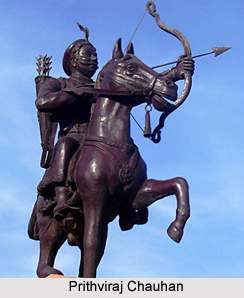 Prithviraj Chauhan was the last Rajput ruler of Delhi. The Chauhans, led by the grandson of Prithviraj, Govinda, later established a small state around Ranthambore. The Rever Maharaja Ranavghansinh ruled Taranga in the eleventh century. The Tomaras later established themselves at Gwalior, and their ruler Man Singh had built a fortress. Muhammad`s armies brought down the Gahadvala kingdom. Some surviving members of the dynasty had taken refuge to the western desert, formed the Rathore clan, and found the state of Marwar. The Kachwaha clan came to rule Dhundhar, their capital being Amber. The Katoch clan, the Chauhans of Chamba and certain clans of Uttarakhand and Nepal had emigrated to Himalayas.
Prithviraj Chauhan was the last Rajput ruler of Delhi. The Chauhans, led by the grandson of Prithviraj, Govinda, later established a small state around Ranthambore. The Rever Maharaja Ranavghansinh ruled Taranga in the eleventh century. The Tomaras later established themselves at Gwalior, and their ruler Man Singh had built a fortress. Muhammad`s armies brought down the Gahadvala kingdom. Some surviving members of the dynasty had taken refuge to the western desert, formed the Rathore clan, and found the state of Marwar. The Kachwaha clan came to rule Dhundhar, their capital being Amber. The Katoch clan, the Chauhans of Chamba and certain clans of Uttarakhand and Nepal had emigrated to Himalayas.
Rajputs in British Empire
The trend of political relations between Rajput states and the central power of the Mughal emperors was the pioneer for similar relations between them and the British rule. The eighteen states in the Rajputana region, out of which fifteen were ruled by Rajputs, entered into alliance with the British East India Company and became princely states under the British Rule. The British also took control of Ajmer, which became the province of Ajmer-Merwara. A large number of other Rajput states in central and western India made similar pacts. Most of them were placed under the Central India Agency`s authority and the various agencies of state of Kathiawar.
Rajputs after Independence
The Maharajas were given undue recognition and an annual amount was endowed to them. Many entered into affairs of state and served as elected representatives. However, later on the Maharajas were de - recognized and the system of annual endowment was also abolished.
The Mair Rajputs today are found in the states of Punjab, Haryana, Himachal Pradesh, Jammu and Kashmir, and Rajasthan. The capital city of India, Delhi also contains a number of Mair Rajputs. Many Mairs are goldsmiths today because that is recognized as their traditional occupation. Sikh Rajputs are the followers of Sikhism belonging to the Rajput social group. Many Punjabi Rajput families are also enrolled in the Guru`s Army, or Khalsa Panth, and baptized as Khalsa Sikhs.
Today the kingdoms have been transformed into famous hotels and tourist destinations, though the Maharajas fulfill some of the ceremonial duties. Rajput men and women are still much involved with elaborate ceremonies, especially weddings, for these are the rituals of Rajput identity. There are modern Rajputs who are followers of the Swaminarayan sect, of Ramanuja, or of Vallabhacharya. These groups are all vegetarians, but other Hindu Rajputs, the majority, are Shaivites.






